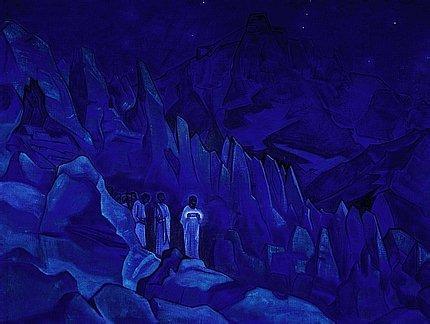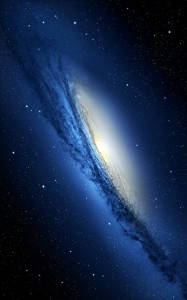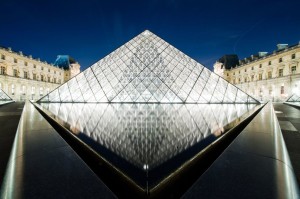 This series of articles about Art can be opened with a seemingly unusual formula by associating the idea of art with that of the master.
This series of articles about Art can be opened with a seemingly unusual formula by associating the idea of art with that of the master.
A master is one who has acquired the art or mastery of being a certain way (wise, magnetic, powerful, brilliant…) by having applied forces or knowledge perfectly, thus being able, through him/herself and his/her work, to improve Space, improve forms and consciousness, to beautify them.
Mastery is art, and art is mastered forces, processes and means which express not simply any inner motion or need pressing from within the individual or collective consciousness, but express union with Reality.
 Art can not indiscriminately serve any need of self-expression, which ranges from the most coarse instinct to purest inspiration. Truly artistic expression would be that in service of Ideas or real values, those able to improve, if applied, the lives of all. Ideas such as Beauty, Harmony, Renewal, Joy, Power, Love … would be (and here of course are intended as) those Potencies able, when intercepted or conveyed with mastery, to precipitate “doses” of Reality: universal essences condensed here into a flower; there in a cathedral; or in a galaxy; music; a smile; a scientific, philosophical or religious research and discovery; an educational, political or economic system; or anything else which can actually improve or advance, in our case, the entire human community.
Art can not indiscriminately serve any need of self-expression, which ranges from the most coarse instinct to purest inspiration. Truly artistic expression would be that in service of Ideas or real values, those able to improve, if applied, the lives of all. Ideas such as Beauty, Harmony, Renewal, Joy, Power, Love … would be (and here of course are intended as) those Potencies able, when intercepted or conveyed with mastery, to precipitate “doses” of Reality: universal essences condensed here into a flower; there in a cathedral; or in a galaxy; music; a smile; a scientific, philosophical or religious research and discovery; an educational, political or economic system; or anything else which can actually improve or advance, in our case, the entire human community.
Art is not restricted to “fine arts” (music, poetry, painting, sculpture, architecture …), but mastery expressed in any field.
What is better is also more beautiful. But are we able to recognize and consequently express Beauty? For instance, beautiful people (physically attractive) are not necessarily beneficent; what is preferred or more comfortable for us is not necessarily more beautiful or absolutely better.
Plato admirably expresses the various degrees of beauty, starting from the aesthetic one to arrive, after 6 stages, at the pure Idea of Beauty.
If it is recognized that
Beauty is the basis of Expressing
it can be said that the Idea of Beauty is the basis or foundation or necessity of any real expression or form, i.e., with power to “be and persist.”
Thus, among human beings, genuinely beautiful is the individual or collectivity which has learned the art of being, the art of living, transforming their (and others’) life – wherever and however the conditions are – into a miracle, i.e., a manifestation on earth of a supermundane law, or universal:
Pure art is the true expression of the radiant spirit.[1]
The Beautiful, always with Plato, is what is True and Good.
Touching on the philosophy of Beauty, we could also formulate that if Life is “what is“, Beauty is the sign of union with Life, “is the splendor of Truth,” is Reality and the Common Good. The form of a flower or butterfly can last one day, but their beauty is eternal, “is and exists” even when no longer perceived by the senses.
Thus the real Art would be possible only as an expression of Union between the world of universal ideas and that of forms, between essences and existences. All that is ugly would not really exist, i.e., would not have the power of persistence.[2]
 As above, so below is the formula which expresses this Union. The above is reflected below and, when corresponding and in accordance, the result is Beauty, which cancels out any distinction of value between higher and lower and reveals the splendor of their union.
As above, so below is the formula which expresses this Union. The above is reflected below and, when corresponding and in accordance, the result is Beauty, which cancels out any distinction of value between higher and lower and reveals the splendor of their union.
If Beauty radiates Truth, a work of art can not express what is “false”, partial, limited, mediocre.
The work of Art is beautiful and useful.
Nowadays, every expression of unusual or “original” content is called art, thereby preferencing freedom of expression to the necessity of Quality, relentless pursuit of improvement, mastery in any field of evolution and general usefulness. Cannot the colors and scent of a flower be beautiful and useful for everyone? …or a sunset? …or the iridescent light of windows of certain Gothic cathedrals? …or the solemnity of a bridge capable of uniting two lands connected by miles of sea? Can Venice be ugly, or our beautiful blue Planet seen from Heaven?
Beauty is equally recognizable in a direct and simple way also in the human domain: everyone (who has a minimum of sensitivity) can recognize an excellent musician or politician or mother of a family, because “the goodness of the tree is known by its fruits.” Yet, this simple truth is forgotten, and value and merit no longer recognized or respected or exacted (past participle of exact-ing). In general, mediocrity, confusion and distraction seem to prevail, and we thereby give credit to those who scream louder, to complication as a sign of knowledge, to advantage as the priority, to seductiveness, sometimes fraudulent, of so many opinions of uninformed as well as expert people.
At this level of instinctive and emotional intelligence (kamâ-Manas) or “mass consciousness”, nothing and no one improve.
If any mastery or art is, on the other hand, the result of a long and unceasing path of self-perfection, why should any sector of human activity be an exception? Thus value and merit, quality, cannot be bypassed or demonized as expressions of elitist presumption; on the contrary, they will be exacted by human community, by illuminated “collective consciousness”, and recognized as a concentrated manifestation of Common Good or Reality, that Light whose brightness can illuminate Space and guide consciousness.
Art is Mastery; every great artist has become such as guided by a Master, manifest or ideal, identified or diffused in his/her inner wisdom, which has been leading the student on the path of infinite perfection.
Art is not imperfection, lawless, randomness or need for self-expression, but powerful sensitivity, attentive and penetrating genius, enthusiastic dedication, freedom from conditioning (general as well as personal) and, above all, an expression of Beauty.
Here the Mastery of the supreme artist, Nature:
Remember, Art is the one vital medium of the coming culture.[3]





